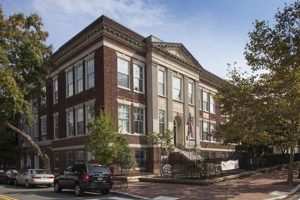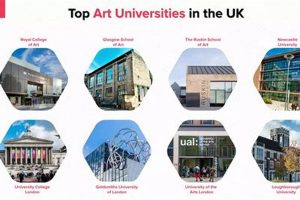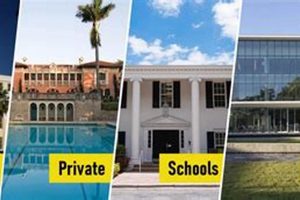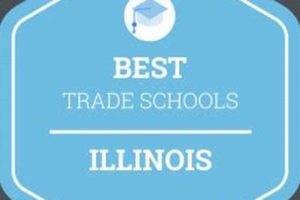Top-tier institutions specializing in adapted learning environments and individualized instruction cater to students with diverse learning differences, including cognitive, physical, emotional, and developmental needs. These institutions often employ highly qualified educators trained in specialized methodologies and assistive technologies, offering smaller class sizes and tailored support services. For instance, a school focusing on dyslexia might employ Orton-Gillingham trained teachers and utilize multi-sensory learning approaches.
Providing an optimal learning environment for students with disabilities is crucial for their academic, social, and emotional development. Specialized instruction and resources empower these students to reach their full potential, fostering independence and preparing them for successful transitions into adulthood. Historically, educational opportunities for students with disabilities were limited. The evolution towards inclusive practices and specialized schools reflects a growing understanding of individual learning needs and the importance of providing appropriate support.
This article will explore factors to consider when selecting an appropriate learning environment for students with special needs, including curriculum, teaching methodologies, support services, and accreditation. It will also delve into the legal framework governing special education and the role of parental involvement in ensuring effective educational outcomes.
Tips for Selecting Optimal Learning Environments
Choosing the right educational setting is paramount for students with diverse learning needs. The following tips offer guidance for navigating this important decision.
Tip 1: Prioritize Individualized Education Programs (IEPs).
Ensure the institution develops and implements comprehensive IEPs tailored to each student’s specific strengths and challenges. A well-crafted IEP outlines specific learning goals, accommodations, and support services.
Tip 2: Evaluate Teacher Expertise.
Seek institutions with faculty specializing in various learning differences and trained in evidence-based instructional strategies. Look for certifications and experience relevant to the student’s specific needs.
Tip 3: Consider Class Size and Student-Teacher Ratio.
Smaller classes allow for more individualized attention and support. A lower student-teacher ratio facilitates personalized instruction and more frequent interaction with educators.
Tip 4: Assess the Learning Environment.
Visit prospective schools to observe classrooms and interact with staff. Evaluate the physical environment, accessibility, and availability of assistive technologies and resources.
Tip 5: Investigate Support Services.
Inquire about the availability of counseling, speech therapy, occupational therapy, and other relevant support services. A comprehensive support system is crucial for holistic student development.
Tip 6: Research Accreditation and Reputation.
Accreditation ensures the institution meets specific quality standards. Research the school’s reputation within the special education community and consider parent testimonials and reviews.
Tip 7: Explore Transition Programs.
Consider programs that prepare students for successful transitions to post-secondary education, vocational training, or independent living, depending on their individual goals and abilities.
Selecting an appropriate learning environment requires careful consideration of individual student needs and institutional resources. By considering these tips, families can make informed decisions that empower students to reach their full potential.
The subsequent section will delve deeper into specific types of special education programs and the unique benefits they offer.
1. Individualized Instruction
Individualized instruction forms the cornerstone of effective special education programs. It recognizes that students with disabilities learn at different paces and in diverse ways. Distinguished special education schools prioritize individualized approaches to maximize student progress and engagement.
- Tailored Learning Plans:
Individualized Education Programs (IEPs) serve as personalized roadmaps for each student’s educational journey. These plans outline specific learning goals, accommodations, modifications, and support services based on individual strengths, needs, and learning styles. For example, a student with autism might have an IEP that includes sensory breaks, visual supports, and social skills training.
- Adaptive Teaching Strategies:
Educators in effective special education settings employ a range of teaching strategies adapted to diverse learning profiles. These may include multi-sensory instruction, assistive technologies, project-based learning, and differentiated instruction. A student with dyslexia might benefit from multi-sensory reading instruction using Orton-Gillingham methodology.
- Progress Monitoring and Assessment:
Regular monitoring and assessment are essential to track individual student progress and adjust instruction as needed. Data-driven decision-making ensures that interventions remain effective and aligned with student goals. Formal and informal assessments provide insights into a student’s understanding of concepts and inform adjustments to their individualized learning plan.
- Collaboration and Communication:
Effective individualized instruction requires ongoing collaboration among teachers, parents, therapists, and other professionals involved in the student’s education. Open communication channels ensure that everyone is working together to support the student’s unique needs. Regular IEP meetings facilitate this collaborative process.
These interconnected facets of individualized instruction contribute significantly to the success of students with disabilities in specialized educational settings. By tailoring learning experiences to individual needs and fostering a collaborative approach, premier special education schools empower students to reach their full potential and achieve meaningful outcomes. The presence of robust individualized instruction serves as a key indicator of a high-quality special education program.
2. Specialized Curriculum
A hallmark of leading special education schools is a specialized curriculum meticulously designed to address the unique learning needs and abilities of students with disabilities. This tailored approach goes beyond simply modifying general education materials; it involves creating learning experiences that are engaging, accessible, and aligned with individual student goals.
- Adaptive Content and Materials:
Specialized curricula utilize adapted learning materials and assistive technologies to ensure accessibility for all learners. This might include modified textbooks, large-print materials, audio recordings, visual aids, and adaptive software. For students with visual impairments, braille materials and screen readers are essential components of a specialized curriculum. This adaptation ensures equal access to information and promotes independent learning.
- Multi-Sensory Instruction:
Incorporating multiple sensory modalitiesvisual, auditory, kinesthetic, and tactileenhances learning for students with various learning differences. For example, students with dyslexia often benefit from multi-sensory reading instruction that combines visual, auditory, and kinesthetic activities. This approach engages different parts of the brain, strengthening learning pathways and improving comprehension.
- Functional Life Skills:
Specialized curricula often emphasize functional life skills development, equipping students with the skills necessary for independent living, employment, and community participation. This may include instruction in daily living skills, social skills, vocational skills, and self-advocacy. For students with intellectual disabilities, a specialized curriculum might focus on practical skills like cooking, cleaning, and money management, preparing them for greater independence.
- Differentiated Instruction:
Recognizing that students learn at different paces and in diverse ways, effective specialized curricula employ differentiated instruction techniques. This involves tailoring teaching methods, learning activities, and assessment strategies to meet individual learning styles and needs. For instance, a teacher might provide different levels of reading material or offer alternative assignments to cater to varying skill levels within a classroom.
These facets of specialized curricula contribute significantly to the creation of learning environments that are responsive, engaging, and empowering for students with disabilities. By prioritizing individualized learning and providing access to adapted materials and methodologies, top special education institutions pave the way for students to achieve academic success, develop essential life skills, and transition successfully into adulthood. The presence of a robust and thoughtfully designed specialized curriculum is a key indicator of a high-quality special education program.
3. Teacher Expertise
Highly qualified educators form the cornerstone of exceptional special education programs. Teacher expertise directly influences student outcomes and contributes significantly to the overall effectiveness of specialized instruction. Leading special education schools prioritize recruiting and retaining educators with specialized training, experience, and a deep understanding of diverse learning needs.
- Specialized Certifications and Training:
Teachers in top special education schools possess specialized certifications and advanced training in areas such as learning disabilities, autism spectrum disorder, intellectual disabilities, emotional and behavioral disorders, and assistive technologies. This specialized knowledge equips them to effectively address the diverse learning needs of their students. For example, a teacher specializing in autism might hold a Board Certified Behavior Analyst (BCBA) certification, enabling them to implement evidence-based interventions for students with autism.
- Experience with Diverse Learners:
Experienced educators possess a nuanced understanding of how students with disabilities learn and develop. They are adept at adapting instructional strategies, differentiating instruction, and creating inclusive learning environments that cater to individual strengths and challenges. A teacher with years of experience working with students with dyslexia will have a deep understanding of the various multi-sensory reading interventions and how to tailor these approaches to individual student needs.
- Collaboration and Communication Skills:
Effective special education teachers are skilled collaborators who communicate effectively with students, parents, therapists, and other professionals involved in the student’s education. They understand the importance of teamwork and work collaboratively to develop and implement individualized education programs (IEPs) and monitor student progress. Regular communication with parents and therapists ensures that everyone is working together to support the student’s unique needs.
- Commitment to Professional Development:
Exceptional special education teachers demonstrate a commitment to ongoing professional development, staying abreast of the latest research, best practices, and advancements in the field. They actively seek opportunities to enhance their skills and knowledge, ensuring they are equipped to provide the most effective instruction possible. This might involve attending conferences, participating in workshops, or pursuing advanced certifications.
The collective expertise of the teaching staff significantly impacts the quality of education provided in special education settings. Schools that prioritize recruiting and retaining highly qualified educators with specialized training, diverse experience, strong collaboration skills, and a commitment to professional development create optimal learning environments where students with disabilities can thrive. This focus on teacher expertise distinguishes exceptional special education programs and contributes directly to improved student outcomes.
4. Supportive Environment
A supportive environment is integral to the efficacy of best special education schools. This environment encompasses not only the physical space but also the social-emotional climate and the overall culture of inclusivity and acceptance. It fosters a sense of belonging and empowers students to develop self-confidence and resilience. The presence of a supportive environment directly influences student engagement, academic progress, and overall well-being. A school prioritizing emotional well-being, for example, might offer counseling services, implement anti-bullying programs, and foster a culture of respect and understanding among students and staff. This creates a safe and nurturing space where students feel comfortable taking risks, asking for help, and celebrating their individual strengths.
The physical environment in leading special education schools is designed to be accessible and accommodating to diverse needs. This includes considerations for mobility, sensory sensitivities, and assistive technologies. Classrooms might feature flexible seating arrangements, quiet areas for sensory breaks, and specialized equipment to support students with physical disabilities. Furthermore, the social-emotional environment is cultivated through positive behavior interventions and supports, anti-bullying initiatives, and social skills training programs. A school focusing on social-emotional learning might implement a restorative justice program to address conflict resolution and build positive relationships among students. Such initiatives create a positive and inclusive school climate where students feel safe, respected, and valued.
A truly supportive environment extends beyond the classroom to encompass the entire school community. Collaboration among teachers, administrators, support staff, parents, and students is essential for creating a cohesive and nurturing environment. Open communication channels, regular parent-teacher conferences, and opportunities for parental involvement contribute to a shared understanding of student needs and a collaborative approach to supporting student success. This collaborative approach fosters a sense of community and ensures that all stakeholders are working together to create an environment where every student can thrive. The presence of a supportive environment, encompassing both physical and social-emotional aspects, is a hallmark of best special education schools and a critical factor in achieving positive student outcomes.
5. Assistive Technologies
Assistive technologies play a pivotal role in distinguishing best special education schools. These technologies serve as essential tools, fostering independence and enabling students with disabilities to access the curriculum, participate fully in classroom activities, and reach their full learning potential. The integration of assistive technologies is not merely a supplementary feature but a fundamental component of a high-quality special education program. The effective implementation of these technologies requires careful assessment of individual student needs, appropriate selection of devices and software, and ongoing training and support for both students and educators. For example, a student with dyslexia might utilize text-to-speech software to access written materials, while a student with a physical disability might use adaptive keyboards and mice to navigate computer programs. Augmentative and alternative communication (AAC) devices empower students with communication difficulties to express themselves and engage in social interactions.
The strategic use of assistive technologies goes beyond simply providing access to information; it promotes active learning, skill development, and increased independence. Assistive technologies can be tailored to address a wide range of learning differences, including visual impairments, hearing impairments, learning disabilities, physical disabilities, and communication disorders. For instance, students with visual impairments can benefit from screen readers and braille displays, while students with hearing impairments might utilize assistive listening devices and closed captioning systems. Furthermore, assistive technologies can support students in developing essential life skills, such as using public transportation, managing finances, and engaging in vocational activities. The appropriate application of these technologies empowers students to overcome barriers and participate more fully in all aspects of their education and lives.
Successful integration of assistive technologies requires a comprehensive approach, encompassing assessment, training, and ongoing support. Best special education schools invest in professional development for educators to ensure they are knowledgeable about the various assistive technologies available and skilled in their implementation. Ongoing technical support is essential for troubleshooting any issues and ensuring that the technologies are functioning optimally. Moreover, collaboration among teachers, therapists, assistive technology specialists, and families is crucial for developing individualized plans that effectively incorporate assistive technologies into the student’s learning experience. The seamless integration of assistive technologies represents a significant investment, but it is an essential element of creating truly inclusive and effective learning environments for students with disabilities. This commitment to providing access to and support for assistive technologies is a key differentiator of exemplary special education programs.
6. Transition Planning
Effective transition planning is a hallmark of best special education schools, recognizing that education extends beyond the classroom and encompasses preparation for adult life. This planning process, ideally beginning no later than age 16, but often initiated much earlier, is a crucial bridge connecting the structured environment of school with the greater independence and diverse demands of adulthood. It focuses on equipping students with the necessary skills and resources to navigate post-secondary education, vocational training, employment, independent living, and community participation. For example, a transition plan might include career counseling, job shadowing opportunities, independent living skills training, and assistance with applying for post-secondary education programs or vocational training. Without a well-defined transition plan, students with disabilities risk facing significant challenges adapting to the demands of adult life, including underemployment, difficulty with independent living, and limited community engagement.
Transition planning within best special education schools involves a collaborative, individualized approach. A comprehensive transition plan considers the student’s strengths, interests, needs, and goals. It involves input from various stakeholders, including the student, parents, educators, therapists, and community support professionals. The process typically includes a thorough assessment of the student’s skills and abilities, development of individualized goals, and identification of necessary supports and resources. For a student interested in pursuing post-secondary education, the transition plan might involve college visits, assistance with completing applications and financial aid forms, and coordination with disability services offices at prospective colleges. For a student pursuing vocational training, the plan might focus on developing specific job skills, arranging internships or apprenticeships, and connecting with potential employers.
The inclusion of comprehensive transition planning is a key indicator of a high-quality special education program. Effective transition planning significantly improves post-school outcomes for students with disabilities, promoting greater independence, self-advocacy, and successful integration into adult life. Challenges in implementation can include limited resources, inadequate coordination among stakeholders, and lack of awareness regarding available support services. However, when implemented effectively, transition planning empowers students to navigate the transition to adulthood with confidence and achieve their full potential as contributing members of society. The long-term benefits of robust transition planning underscore its importance as a critical component of best special education schools.
Frequently Asked Questions
This section addresses common inquiries regarding optimal learning environments for students with diverse learning needs. Understanding these key aspects can assist families in making informed decisions.
Question 1: How does one determine the most suitable learning environment for a child with special needs?
Determining the most suitable learning environment requires careful consideration of the child’s individual needs, learning style, and the available resources in various settings. Consultation with educators, therapists, and other professionals involved in the child’s development is crucial. A comprehensive evaluation and a well-defined Individualized Education Program (IEP) are essential for guiding this decision.
Question 2: What are the key indicators of a high-quality special education program?
Key indicators include individualized instruction, specialized curricula, highly qualified and experienced teachers, a supportive and inclusive environment, access to assistive technologies, and robust transition planning. Furthermore, strong communication and collaboration between educators, parents, and therapists are essential components of effective programs.
Question 3: What role do parents play in the special education process?
Parents play a vital role as advocates for their children. Active participation in IEP meetings, open communication with educators and therapists, and ongoing monitoring of the child’s progress contribute significantly to the success of special education programs. Parents’ insights into their child’s strengths, challenges, and learning preferences are invaluable for developing and implementing effective educational strategies.
Question 4: What are the different types of special education settings available?
Several options exist, including inclusive classrooms within general education settings, self-contained classrooms within mainstream schools, specialized schools dedicated solely to special education, and residential programs for students with more intensive needs. The most suitable setting depends on the individual student’s needs and the level of support required.
Question 5: What are the benefits of assistive technologies in special education?
Assistive technologies empower students with disabilities to access the curriculum, participate more fully in classroom activities, and develop greater independence. These technologies can address a wide range of learning differences, providing individualized support and fostering greater engagement in the learning process.
Question 6: What is the importance of transition planning in special education?
Transition planning prepares students for the transition from school to adulthood, focusing on post-secondary education, vocational training, employment, independent living, and community participation. It equips students with the essential skills and resources they need to succeed in adult life.
Addressing these common questions clarifies critical aspects of special education and assists families in navigating the decision-making process. Open communication with educators and a thorough understanding of available resources are key to ensuring that students with special needs receive the appropriate support to reach their full potential.
For further information on specific disabilities and educational strategies, please consult the resources provided in the following section.
Conclusion
Optimal learning environments for students with diverse learning needs prioritize individualized instruction, specialized curricula, expert educators, supportive settings, assistive technologies, and robust transition planning. These interconnected elements contribute significantly to academic success, skill development, increased independence, and successful transitions into adulthood. Effective programs recognize that education extends beyond academics, encompassing social-emotional growth and preparation for fulfilling lives beyond the classroom.
The pursuit of excellence in special education requires ongoing commitment, collaboration, and advocacy. Continued investment in research-based methodologies, professional development for educators, and accessible resources is essential for ensuring that all students with disabilities have the opportunity to reach their full potential and thrive as contributing members of society. The focus remains on fostering inclusive communities where individual differences are celebrated and every learner is empowered to succeed.




![Top Middle School Backpacks for Girls [2024] Best Schools in America: Top Public & Private Options Top Middle School Backpacks for Girls [2024] | Best Schools in America: Top Public & Private Options](https://schoolsinamerica.us/wp-content/uploads/2025/10/th-1493-300x200.jpg)


